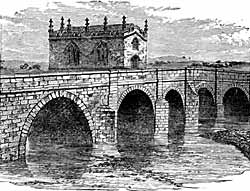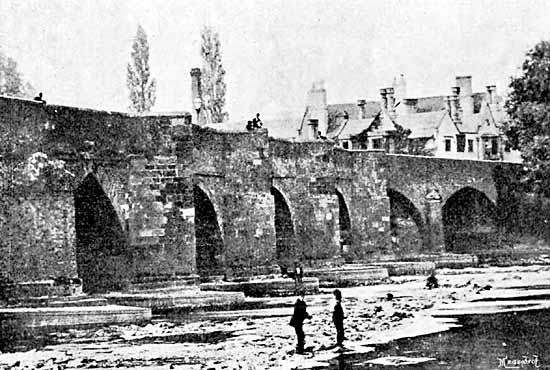The Trent Bridges, Nottingham
By John Potter Briscoe
 |
| Henry II. |
THE history of the Trent bridges at Nottingham is particularly interesting. The site of these bridges has for many hundred years been the crossing-place of the Trent, between the south of England and the north. During the excavations for the foundations of the new bridge (to which we shall refer subsequently), traces of what we may infer to have been a landing stage were brought to light. These consist of some "cross-braced framing, formed of black oak beams trenailed together with oak pins, the whole resting upon large unhewn blocks of stone."
The earliest intimation of the existence, if not of the origin, of a bridge crossing the Trent at Nottingham is gleaned from the Saxon Chronicle (Corpus Christi MS.) where, under the year 924, it is recorded that " this year before midsummer, went King Edward (the Elder) with an army to Nottingham, and ordered the 'burg' to be wrought on the south side of the river opposite to the other, and the bridge over the Trent betwixt the two burgs." It is probable that the piers were composed of stone, and the platform, if not the entire superstructure, of wood. A bridge here, however, was of the greatest utility, inasmuch as it united the northern and southern parts of the country, and no doubt contributed considerably to the wealth and importance of Nottingham, which became "a great thoroughfare between the two grand divisions of the island for the marching of armies and conveyance of merchandise to and from the north of England and Scotland." (Orange's History and Antiquities of Nottingham, p.83.)
It is supposed that in a.d. 1156, Henry II. rebuilt the strong stone wall with which Edward the Elder encircled the town, and if that statement is correct, may have also built the first arched bridge of stone. Supposing this to have been the case, then this was one of the earliest stone bridges erected in England, the first stone bridge having been the Bow bridge, built in 1118. (Strutt's Horda-Angel Cynnan, 1774-1776, ii., p. 46.)
Between the years 1222-1235 a grant was made to the Hospital of St. John the Baptist by its founder of three roods of land " at the bridge of Hebeye." (Records of the Borough of Nottingham, i., p. 17.)
 |
| Bridge chapel at Rotherham. |
In the thirtieth year of the reign of Edward I. (1301-2) a licence was granted to John le Paumer of Nottingham, and his wife Alice, to give £6 13s. 4d. in rent, for two chaplains (Thoroton says one chaplain) in the chapel of St. Mary, situated on the Trent bridge, then known as Hethebechebrigge. (Inq. post Mort, i., p. 177.) This grant was for the celebration of "divine offices for their souls," &c. (Thoroton's Antiquities of Nottinghamshire, 1699, p. 492, c. 2.) It was customary to annex chapels to the principal bridges of the country. These sometimes extended across the bridge, the roads passing through their centre. The reading-desk and pulpit occupied one side, and the congregation the other. (Nash' Collections for the History of Worcestershire, p. 329.) Whilst the bridge was under repair in July, 1826, a number of pieces of sculptured stone were found under the sixth arch from Nottingham, some of which were beautifully wrought mullions of windows. Doubtless these remains belonged to this ancient chapel of St. Mary.
The Trent Bridge in 1319 was designated "the bridge of Hethebethe. (Records, i., p. 382); and in the same work (i., p. 97) reference is made of an assault being committed and a man being charged with stealing "the timber of the Bridge of Hethebethe," in 1324.
In 1364, the structure being in a very dilapidated state, it was ordered that an inquisition "be made to ascertain who ought to repair the bridge of Hethbethbrigg, near Nottingham; and until it was ascertained, and the bridge repaired, Stephen Rombylowe, Constable of the Tower, was ordered to find a passage by a barge or boat, and for every man passing over he should take 1/4d., for every horse, 1/2d., a loaded cart, 1d., unloaded, 1/2d.; and for everything passing by the barge of the value of forty shillings, 1d., twenty shillings, 1/2d., ten shillings, 1/4d.; and from the profits the barge was to be constructed, and the wages of those employed in it paid, and what was over reserved for the king." (Ab Rot. Orig. ii., p. 273.)
Parliament was petitioned in 1374 by the commonalty of the counties of Nottingham, Derby, and Lincoln, and the town of Nottingham, that the county and town of Nottingham might appoint two guardians, who could purchase lands for the maintenance of the Trent bridge, then called Heybeth bridge. (Bailey's Annals of Nottinghamshire, i., p. 261.) It would appear that this petition being acceded to, the oft-mooted point of bridge-masters would be settled. That the three counties contributed largely to the funds whereby the lands and hereditaments were to be purchased, there can be no doubt; thenceforward the expense of maintaining the bridge devolved upon the town of Nottingham.
Under date August 22, 1397, is this note in the first volume of the Nottingham Corporation Records (p. 353) which states that William Gye and Richard dc Langar appeared against Robert Bell for the recovery of "a hundred shillings for the collection of the Ferm of the Bridge of Heyebeth, for which 100s. the same Richard and William are bound to pay to the Mayor and Chamberlains and to Richard Verdesaux by their obligatory writing, which hundred shillings [were] rec[overed] in full court of the liberty of the town of Nottingham by aforesaid Richard Verdesaux." The defendant subsequently acknowledged the debt.
By will dated February 12, 1410-11, Robert Squire of Nottingham left to "the great bridge called Hebeth-BRYGGE, near the town of Nottingham twenty shillings in silver." (Records, ii., p. 83.) From an indenture, dated 1416, in the Nottingham Archives, we learn that an annual payment was made by the Lord of Gamston for the repair of "Hebethbrigge" for the souls of the ancestors of Geoffrey Luterel, the Lord of Gamston. (Ib. 109.)
In a judgment of the court concerning the repair of the Leen bridge, about 1457, the Trent bridge is mentioned as the Heyghbeythbrugge. (Deering's Nottinghamia Vetus el Nova, 1751, pp. 33/-S.)
Mr. W. Henry Stevenson in the introduction to the second volume of the town records, informs us (p. xvi.) that "there are no Accounts of the Bridge-Wardens or Bridge-Masters preserved of earlier date than 1457-8. The only other one of this period embraces the year 1458 to 1461. These are accounts of moneys received for, and expended upon, the reparation of the great Hethbeth or Trent Bridge. The sustentation of this Bridge ... was a great burden upon the town in the Middle Ages. The Accounts consist of a summary written in Latin on parchment, of the receipts and expenditure of the Bridge-Wardens for the time being." The two summaries are printed at pages 220-4, and the particulars of expenditure of one of these accounts are given at page 364 of the volume quoted from.
In a deed made by the Mayor, Recorder, Keepers of the Peace, the two Wardens of the Bridges of Hethbeth, and the two Sheriffs and Chamberlains, on October 10, 1467, it is stated that "the bridge of HETHBETH over the Trent" was sustained only by gifts, and that " there is found there a fit priest in the chapel built upon the said bridge daily celebrating divine service in honour of our Saviour and of the Blessed James the Apostle and of All Hallows, for all the helpers and benefactors of the bridge." The deed appointed "William Thornes and William Chase our certain and true attornies jointly and severally to seek and receive alms and charitable gifts for the reparation, sustentation, and mending of the bridge." (Vide Records, ii., p. 265.)
John Pool of Nottingham, by his will dated April 27. 1479, bequeathed 6s. 8d. "to the mending of the Bridges of Hethbeth." (Records, ii., p. 307.)
A house and portion of land were given in trust for the repair of the bridge by Robert Poole and others on the 22nd May, 1501. (Orange, p. 644.) In 1524 Thomas Willoughby, one of the aldermen of Nottingham, willed to " Hethbeth " four of his best pieces of timber lying at the tile houses (Deering, p. 315); and it is recorded that the chapel, dedicated to St. James, which stood upon the high bridge, possessed lands, in 1535, of the value of £2 6s. 2d. per annum. (Inq. ad quod Dam., p. 127.)
The first lease granted by the bridge estate was on the 8th September, 1541. Richard Kyte, fellmonger, was the lessee, and the property so leased consisted of two parcels of land, called "No Man's Parts," and another piece between Chainy Pools, north and south. (Bailey, i., p. 412.) Elizabeth Gellestrope, by her will dated 12th April, 1543, gave, together with some land, an almshouse containing five dwellings, which were to be inhabited by poor burgesses, placed there by the bridge-masters as vacancies occurred, and thence known as the "Bridgemasters' Hospital." On April 14, 1544, land and gardens were bequeathed for the repair of the Trent bridge by Jacob Mason and John Gregory.
In 1550, 5th Edward VI., "Our late hospital of Saint John, with its rights and appurtenances," was by the King's letters-patent granted to the corporation of Nottingham, for amending, sustaining, and repairing of the Trent bridge at Nottingham. (Orange, ii., p. 645.) This convent stood on the site of the Prison, which was until it was closed for demolition, called the House of Correction. (Bailey, i., pp. 432-433, and see Old Nottinghamshire, i., pp. 1-10.) A committee of seven persons was appointed by "The Hall," in 1609, to sell wood in the Coppice, to obtain money for the repair of the bridge. (Bailey, p. 572.)
Bailey (p. 589) states that, during the year 1614, "it was ordered that the bridge-masters do take up £20 for six months, upon their own bond; and to be allowed it again upon their accounts being passed, as the bridges are in so great decay, and must be repaired this summer." This order appears to have been founded on the following presentment made by the Mickleton jury: "We entreat your worships that the Trent bridge may be carefully seen into, and especially the chapel arch, and mended presently, or else it will go to great decay, for now is the time." One of the middle arches of Trent Bridge fell on the 10th August, 1636; and was rebuilt at a cost of upwards of £100. (Bailey, p. 633.)
The Trent Bridge figured conspicuously during the time of the civil war. Mrs. Hutchinson (Memoirs of Col. Hutchinson, 1806, p. 164) places it on record, that in 1643 the Cavaliers made a fort at the Trent bridge, and thither they carried down all their plunder and prisoners. The same writer states that the Royalists "broke up two arches of the bridges, to hinder the Governor's men from following them," that Mr. George Hutchinson was appointed to keep the fort and bridges, which he did, and that Colonel Hutchinson, Governor of Nottingham Castle, made a new inwark in the fort and bridge. (Ib., p. 190.)
On Sunday, the nth of February, 1644, Cornet Palmer acquainted the Governor of an intention of Hacker's soldiers to surprise the bridge on the following Saturday. On receiving this intelligence, the Governor sent his officers to command the bridge soldiers to keep in their quarters, and directed that all the horse in the town should be kept ready to turn out on the first sound of the trumpet, and gave orders for all the drums in the garrison to beat occasionally in the morning. The Lieutenant-Colonel despatched a guard beyond the bridge, with strict injunctions to examine all passengers. On the following Saturday, 17th February, 1644, at eleven o'clock, they took on the bridge twelve of Hacker's soldiers, who were disguised as market men and women, and armed with pistols, long knives, hatchets, and daggers. The enemy, perceiving that their comrades were taken, retired: only nine were overtaken; these, with their captain, leaped into the Trent; four were saved, live drowned, and the captain swam ashore. (Ibid, p. 189.)
After this occurrence the bridge was fortified more strongly, and as the enemy was expected every hour, operations had to be proceeded with on the Sunday. (Ibid, p. 197.)
Learning that the Governor of Nottingham was in London, a Newark party of Cavaliers devised a scheme for seizing the fort at the Trent bridge at Nottingham. On a Sunday morning about the end of April, 1645, they stormed the fort (which had been left with not more than thirty soldiers on guard), captured it, and put to death nearly the whole—about twenty—of the troops of the garrison at the time. This event threw Nottingham into an uproar. Colonel Hutchinson, hearing of the matter whilst in London, went to the Parliament and told the House how the Newark men had taken the fort, and, for aught he knew, the garrison also. He then hastily returned to Nottingham. (Brown's Annals of Newark, p. 144.) In order to prevent the enemy from obtaining access to Nottingham by the bridge, he caused to be erected a small fort, wherein he placed a lieutenant and thirty men. (Hutchinson, p. 281.) He resolved to assault the enemy from the Nottingham side of the river, after having provided that their friends should not come from the other side to help them. But those of Newark, understanding this, sallied forth in as strong force as they could muster and assaulted the fort, when Lieutenant Hall, who was in command, failing in that courage which he professed when he solicited the honour of keeping the fort, surrendered. On perceiving this, the Governor was exceedingly vexed, and immediately marched up to the bridge with the object of assaulting the new occupants of the fort. He discovered that the enemy stormed the fort only to permit of their own escape. They "made shift" to get at their friends upon the ribs of two broken arches, which, when they had served to help their passage, they pulled up to hinder a pursuit. Thus, after a month's space, the fort was restored to the Governor, who re-fortified the town and repaired the bridge. At the close of the war the garrison was reduced and the works at the bridges were "slighted." (Hutchinson, p. 276.)
 |
| Old Trent Bridge, about 1869. |
